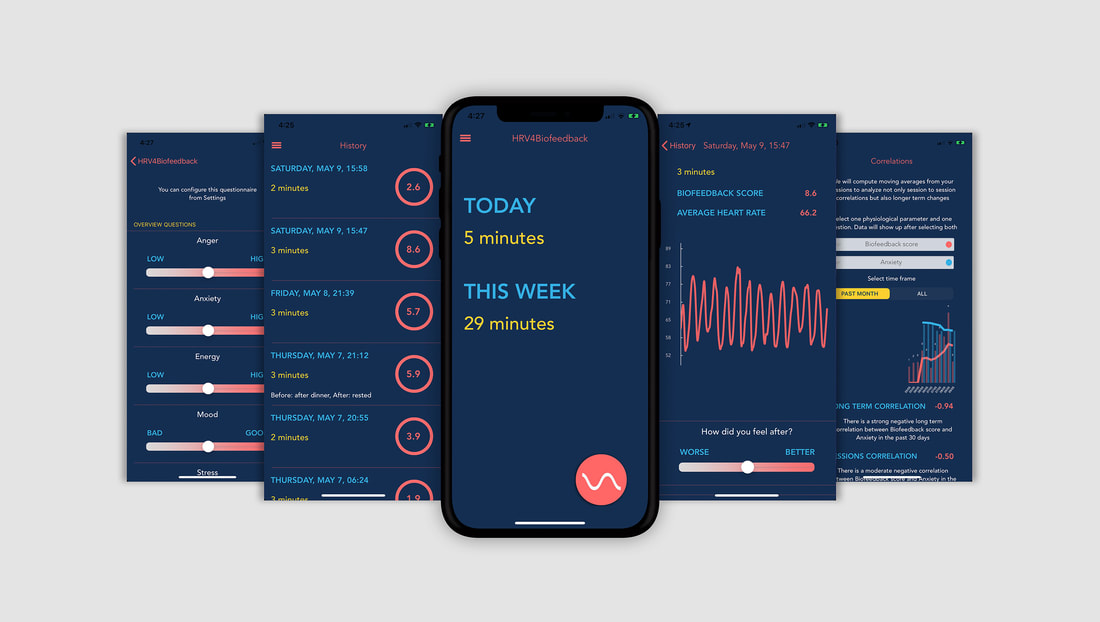|
Blog post by Marco Altini
Life can be demanding, from both a physical and psychological point of view. Our health and performance can be affected by how we are able to effectively cope with stressful situations and deal with anxiety, or in broader terms, our ability to emotionally self-regulate is key Heart Rate Variability (HRV) Biofeedback can directly affect physiological and psychological factors through deep breathing exercises and is an ideal strategy to help us self-regulate and better cope with stressful situations Scientific rationale
Practically speaking, HRV Biofeedback consists of providing an individual with real-time feedback on instantaneous heart rate and respiration changes while being instructed to breathe at low frequencies (Lehrer and Gevirtz, 2014)
From a physiological point of view, we can consider homeostasis as a starting point to understand the rationale behind using HRV Biofeedback. As the body via the autonomic nervous system (ANS) responds to stressful stimuli in an attempt to maintain a state of balance, we can determine how effective this physiological self-regulation process is, by measuring the ANS During HRV Biofeedback, an individual is instructed to breathe at low frequencies. Breathing at low frequencies (or deep breathing) causes large oscillations in the instantaneous heart rate, which synchronize with breathing rate. The influence of breathing on heart rate is called Respiratory Sinus Arrhythmia (RSA) and is mostly modulated by the parasympathetic branch of the ANS (Lehrer and Gevirtz, 2014). Hence, deep breathing results in training of the parasympathetic system, which might explain at least part of the positive effects of HRV Biofeedback reported in the literature in the context of reducing stress and anxiety (Goessl, Curtiss, and Hofmann, 2017) Strengthening the parasympathetic nervous system could also motivate using HRV Biofeedback in athletes, with the potential of improving emotional self-regulation, coping mechanisms, and performance (Khazan, 2016; Pusenjak et al., 2015) Check out these resources to learn more about the physiological underpinnings of HRV Biofeedback: WHAT'S THE DIFFERENCE BETWEEN MORNING HRV MEASUREMENTS AND BIOFEEDBACK?
HRV analysis can be used for various applications. What we do at HRV4Training is to quantify baseline physiological stress (what we could call "chronic" stress), and how this changes in response to training and lifestyle over periods of weeks or longer. To quantify baseline physiological stress, our measurements need to be taken in a very precise moment, which is first thing in the morning, so that we can avoid the effect of confounding factors. You can find a few examples here
By capturing changes in resting physiology, we can provide useful feedback that helps individuals to make meaningful adjustments to better balance training and lifestyle. This is particularly relevant as we all respond differently even to the same stressors depending on various aspects (how novel is the stressor, how much of that stressor we are used to take, what other stressors are present), hence only by measuring our individual response we can figure out if it's all proceeding according to our plans or not WHAT ABOUT HRV BIOFEEDBACK THEN?
HRV Biofeedback is a technique that we use to improve self-regulation, and also strengthen the parasympathetic system. While our morning measurements should be done while resting and breathing naturally, during biofeedback we use deep breathing to elicit higher parasympathetic activity
You can see your biofeedback session the same way you see your other training sessions, this is something you do so that in the longer term, there can be beneficial changes in health and performance. Biofeedback is just a positive stressor WHERE DO REGULAR BASELINE HRV MEASUREMENTS AND BIOFEEDBACK MEET?
Normally we would recommend doing biofeedback exercises as an add on the regular morning measurement done with HRV4Training. Combining biofeedback with morning measurements taken with HRV4Training, you could see also potential changes in baseline chronic physiological stress as measured in a known context (first thing in the morning), as a result of your biofeedback sessions
Try HRV4Biofeedback
You can f ind the app at this link
Or simply stay updated by signing up below Comments are closed.
|




 RSS Feed
RSS Feed
